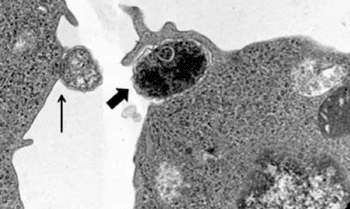Molecular Pair Identified as Key to Host-Cell Invasion by Tick-Transmitted Pathogen
By LabMedica International staff writers
Posted on 22 Oct 2012
A pathogen-host “key and door” molecular pair has been identified as critical for the cell-cell adhesion required for invasion by the tick-transmitted pathogen Anaplasma phagocytophilum. The finding provides an important candidate target for development of drugs and a single vaccine against diseases caused by this and closely related pathogens.Posted on 22 Oct 2012
A. phagocytophilum is an Anaplasmataceae family bacterium responsible for causing granulocytic anaplasmosis in humans; other tick-transmitted Anaplasmataceae species often cause diseases in domestic and livestock animals, including cattle. From studies in vitro using mammalian cell cultures and in vivo using mice, scientists at the Virginia Commonwealth University (VCU; Richmond, VA, USA) School of Medicine have shown that “outer membrane protein A” (OmpA) on the surface of A. phagocytophilum is critically important for its invasion of host cells. They also delineated a specific region in OmpA that mediates infection and is conserved among Anaplasmataceae family species. The research team showed that OmpA binds mammalian host cell surface sialylated glycoproteins and confirmed that this interaction is important for the adhesion stage of infection. "In other words, we identified both a key and door that together promote Anaplasma phagocytophilum infection," said lead investigator Jason A. Carlyon, PhD, associate professor, and a George and Lavinia Blick Scholar in the Department of Microbiology and Immunology of the VCU School of Medicine. "These findings are important because our data also establish a direction for development of a single vaccine that protects against members of an entire family of bacteria that cause disease," he added.

Image: Two Anaplasma phagocytophilum bacteria (arrows) bound to host cell surfaces; the bacterium on the right (thick arrow) is invading upon triggering its own uptake. (Photo courtesy of Jason Carlyon, PhD, and Matthew J. Troese, PhD / VCU.)
The study published online and planned to appear in print in the November 2012 issue of the journal Infection and Immunity (volume 80, issue 11), identifies the first A. phagocytophilum adhesin-receptor pair, and delineates the region of OmpA that is critical for infection. Researchers in Prof. Carlyon's laboratory are presently refining their understanding of the molecular basis for how OmpA promotes infection and are testing its efficacy in protecting against infection by A. phagocytophilum and other pathogenenic Anaplasmataceae members.
Related Links:
Virginia Commonwealth University














